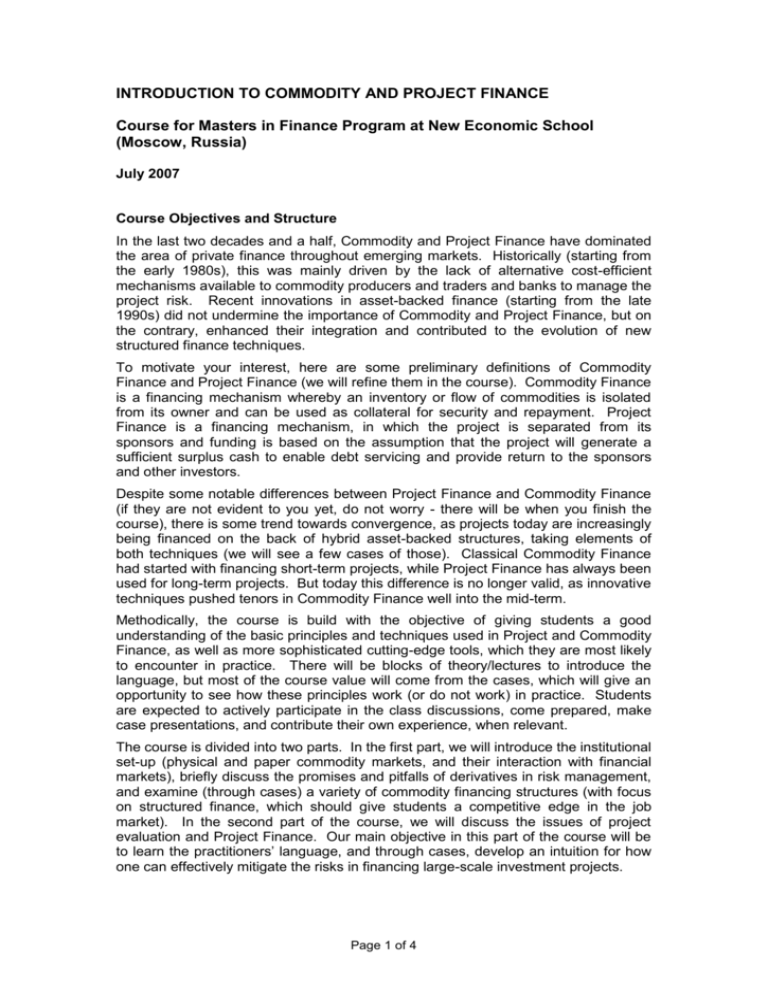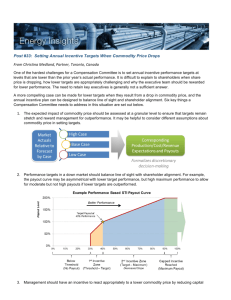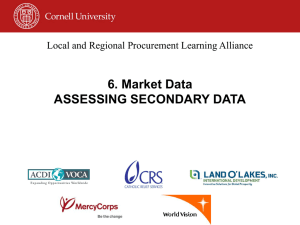Commodity and Project Finance
advertisement

INTRODUCTION TO COMMODITY AND PROJECT FINANCE Course for Masters in Finance Program at New Economic School (Moscow, Russia) July 2007 Course Objectives and Structure In the last two decades and a half, Commodity and Project Finance have dominated the area of private finance throughout emerging markets. Historically (starting from the early 1980s), this was mainly driven by the lack of alternative cost-efficient mechanisms available to commodity producers and traders and banks to manage the project risk. Recent innovations in asset-backed finance (starting from the late 1990s) did not undermine the importance of Commodity and Project Finance, but on the contrary, enhanced their integration and contributed to the evolution of new structured finance techniques. To motivate your interest, here are some preliminary definitions of Commodity Finance and Project Finance (we will refine them in the course). Commodity Finance is a financing mechanism whereby an inventory or flow of commodities is isolated from its owner and can be used as collateral for security and repayment. Project Finance is a financing mechanism, in which the project is separated from its sponsors and funding is based on the assumption that the project will generate a sufficient surplus cash to enable debt servicing and provide return to the sponsors and other investors. Despite some notable differences between Project Finance and Commodity Finance (if they are not evident to you yet, do not worry - there will be when you finish the course), there is some trend towards convergence, as projects today are increasingly being financed on the back of hybrid asset-backed structures, taking elements of both techniques (we will see a few cases of those). Classical Commodity Finance had started with financing short-term projects, while Project Finance has always been used for long-term projects. But today this difference is no longer valid, as innovative techniques pushed tenors in Commodity Finance well into the mid-term. Methodically, the course is build with the objective of giving students a good understanding of the basic principles and techniques used in Project and Commodity Finance, as well as more sophisticated cutting-edge tools, which they are most likely to encounter in practice. There will be blocks of theory/lectures to introduce the language, but most of the course value will come from the cases, which will give an opportunity to see how these principles work (or do not work) in practice. Students are expected to actively participate in the class discussions, come prepared, make case presentations, and contribute their own experience, when relevant. The course is divided into two parts. In the first part, we will introduce the institutional set-up (physical and paper commodity markets, and their interaction with financial markets), briefly discuss the promises and pitfalls of derivatives in risk management, and examine (through cases) a variety of commodity financing structures (with focus on structured finance, which should give students a competitive edge in the job market). In the second part of the course, we will discuss the issues of project evaluation and Project Finance. Our main objective in this part of the course will be to learn the practitioners’ language, and through cases, develop an intuition for how one can effectively mitigate the risks in financing large-scale investment projects. Page 1 of 4 Target Audience The course is relevant for those working or planning to work in commodity corporations or in banking (especially in structured commodity finance, project finance, and credit and risk management). We will interchangeably look at the financing issues from the perspectives of the borrowers and the lenders (you will get used to the idea that one is a mirror image of the other). Please note, this is not a course on Risk Management and Equity Valuation (although we will briefly discuss these issues in application to commodity business, these will not be the core of this course, and students with specific interest in those areas are urged to register for another course). Format and Teaching Methods The course is practice-oriented. We will extend the analysis, which students have developed in the earlier finance classes, to commodity markets and apply theory to real life cases. During the course, we will discuss 8 to 10 cases in detail, with written reports required for only 4 cases (to make the workload manageable). For each case, the students are expected to work in groups (3 to 5 per group), submit a written report before the class in which the case is being discussed, and present at least one case in class (allocation of cases will happen in the first week of the course). One of the benefits of writing the reports (in addition to practicing what you have learned) is to develop valuable skills in writing investment proposals/investment memoranda, etc. Further guidance on case writing will be provided. We may have one or two guest speakers from the industry. If this happens, we may move things around a little bit, to accommodate them into our schedule (you will be notified of any changes in advance). Pre-requisites Corporate Finance and Capital Markets are in theory pre-requisites (but I would be flexible to admit those students who have not even completed the fundamental courses). Familiarity with topics from Options & Futures would be helpful for some topics we will be discussing, but not essential; we will develop what we need in class. Assignments & Assessments The final grade will be based on 4 case write-ups (40%), case presentation and class participation (10%), and final exam (50%). Instructor The course will be taught by Andrey Petrichtche, who has more than 10 years of experience in asset-backed, structured commodity, and project finance with top international banks and commodity firms. In the past, Andrey worked for Westdeutsche Landesbank, Goldman Sachs, European Bank for Reconstruction and Development, and Anglo American (FTSE-100 mining and metals conglomerate). Andrey is currently pursuing PhD at Insead and advising Russian and international companies on issues of corporate financial strategy and project financing. Page 2 of 4 Recommended Reading Unfortunately, there is no single textbook ideally suited for this course. Below is a list of recommended reading, which will nicely complement our discussions in class. Lecture notes will be distributed for each class (which will be sort of “dry residual”). Remember that the area is developing fast, and any good book is likely to be out-ofdate even before it is published. Therefore, students, who want to keep abreast of what is happening in the market today, are encouraged to read the business press regularly (e.g., Commodity Markets columns in FT and The Wall Street Journal). For the first part of the course: Ephraim Clark (2001), “International Commodity Trading: Physical and Derivative Markets,” Wiley. This is a good introduction into commodity markets terminology, which is advisable to read before the course. Joel M. Stern and Donald H. Chew, Jr (2003), “The Revolution in Corporate Finance,” Blackwell Publishing. The Risk Management section has a collection of not too technical papers on the use and misuse of derivatives, with some classical examples (read them at leisure). John Macnamara (2001), “Structured Trade and Commodity Finance: What Can Go Wrong and How to Avoid It,” Woodhead Publishing Ltd. This is a good introduction into structured commodity finance: instruments and terminology. Emmanuelle Moors (2003), “Structured Commodity Finance: Techniques and Applications for Successful Financing Arrangements,” Euromoney. This book gives practitioner’s guidance on some of the financing structures, which we will discuss in class. Hélyette Geman (2005), “Commodities and Commodity Derivatives: Modelling and Pricing for Agriculturals, Metals and Energy,” John Wiley & Sons. This is a very good, and quite recent, book on commodity markets, which I would strongly recommend to each of you who works in this area to have in your library as a reference. For the second part of the course: E. Yescombe (2002), “Principles of Project Finance,” Yescombe Consulting This is a good reference book written by an expert (it has much more technical details than we will be able to cover in 4 classes). “Project Finance in Developing Countries,” (1999), IFC. This book is a very basic introduction into project finance, with some reference to IFC projects (we will see some of the IFC projects in our case studies). Page 3 of 4 Summary of Course Schedule Note: Cases marked with a (*) require a written write-up/report. When there are two cases assigned for any session, you are expected to write only one report (i.e. you may chose between those two), even though for class discussion you are expected to prepare both. I. Commodity Markets and Finance 1. Course overview. Introduction to commodity markets: commodity exchanges; market structure (physical and paper markets); market instruments; contracts; margin accounts. Introduction to commodity derivatives. 2. Fundamentals of commodity price risk management. commodity futures, options & exotics. Hedging with Case 1(a)* - American Barrick (HBS). Case 1(b)* - Risk Management at Apache (HBS). 3. Classical commodity finance (e.g., trade finance, counter-trade, seasonal working capital finance). Introduction to structured commodity finance (e.g., inventory finance, securitization). Structural credit enhancement. Case 2(a) - Russian Gold Pre-Production Financing (EBRD). Case 2(b) - Gazprom Securitization (ABN-AMRO, ML, MS). II. Project Evaluation and Project Finance (with application to commodities) 4. Project evaluation in commodity business (“sterilized” exercises in project cash flow modelling and real option valuation). Developing project financing plan. Case 3* - Project Dragon (Anglo American). 5. Risk analysis in Project Finance. Risk sharing and credit enhancement. Role of export credit agencies. Case 4(a)* - Turkmen Oil (EBRD). Case 4(b)* - Petrozuata (HBS). 6. Project Finance structures. Hybrid forms. Case 5(a) - Oceania Pipeline Financing (Thompson). Case 5(b) - QatarGas Project (Thompson). 7. Managing political risk in Project Finance. Role of IFIs. Case 6* - Financing the Mozal Project (HBS). Page 4 of 4








